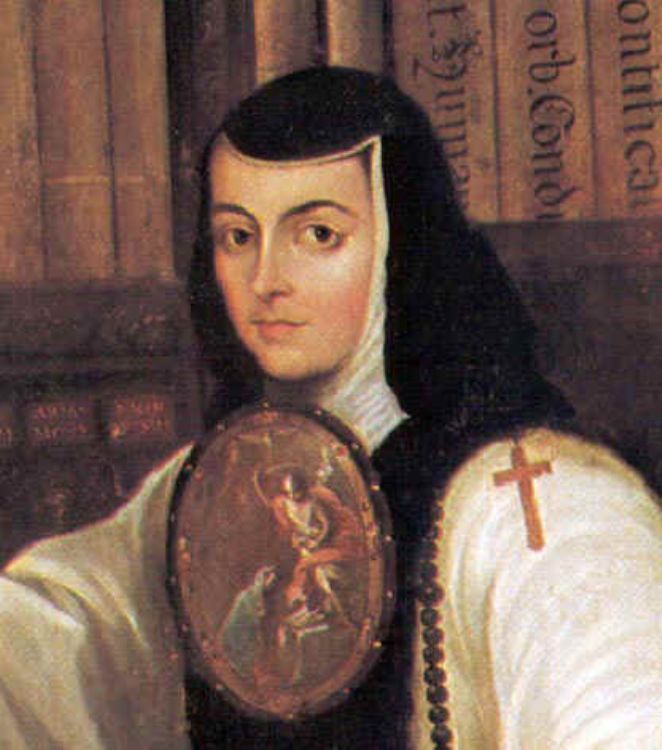Sor Juana Inés de la Cruz

When speaking of Hispanic literature, it is impossible not to mention the writings of Sor Juana, woman of egalitarian ideals. Her life was interesting and since she was young, she showed interest and talent for the world of literature. To some extent, there is a debate about her person, since there are people that consider her the pillar of feminism, while others would just rather think that she was a great intellectual, one of the greatest Mexican women of all times. Broadly speaking, this was her history:
Her Life
She was born in San Miguel Nepantla, in the State of Mexico, although her date of birth varies according to different sources: Some of them place it on December 1648, however, the most commonly accepted date is November 12th,1651. She was given the name of Juana Inés de Asbaje y Ramírez de Santillana. Her parents were an unmarried couple living together (later on, they split) and she was raised mainly under the tutelage of her grandfather, Pedro Ramírez.
When her grandfather passed away, it was her mother who took charge of their land. It was at the age of three when one of her greatest merits took place: she learnt to read at that age. She cultivated herself and got entertained with the book collection of her late grandfather. Later on, she tried to attend university dressed up as a man (since it was not legal for women).
In 1656, she was sent to Mexico City to live with her sister, María. It was at that same moment when she received her first award for a Loa (a brief theatrical piece used to introduce a play) to honor the Blessed Sacrament.
Later on, in 1665, she entered the court of Viceroy Antonio Sebastián de Toledo. The vicereine became one of her protectors and most important benefactors. In the court, she frequented humanists, historians and all type of intellectuals. There, she quickly learnt Latin, gaining proficiency and fluency.
Her intelligence brought about rumors, for example that she was examined by a group of wise men and passed with honors. She kept working as a writer, composing poems, eulogies, and, above all, sonnets.
This is where her unrequited love existence is told. She got bored of living at the court (besides she didnât want to get married), so she decided to join the religious life. After a brief stay with the Order of the Carmelites, she became part of the Order of the Jerónimas, where she renders her vows in 1669. Although she worked as archivist, bookkeeper, and as a clerk in a grocery, she always kept the writing as her primary labor.
She started to write commissioned works, as well as receiving payments from church for carols, loas and theater scripts. She contracted typhoid fever in 1671 and took almost one year to completely recover. Her great protectors, the viceroys, were relieved from their posts in 1674. When vicereine Leonor de Carreto passed away, she showed once again her mastery of wording by writing a beautiful sonnet : De la beldad de Laura enamorado on her honor.
Later, she was entrusted to design the Triumphal Arch for the coronation of the new viceroys, composing then the allegorical Neptune. Having impressed the viceroys, they became her friends. Her most productive and splendid epoch lies from 1680 to 1686, since she published, amongst other writings, her comedies: âAmor es más laberintoâ and âLos empeños de una casaâ (her most admired work) and the so-called religious plays: âEl divino Narcisoâ, âEl cetro de Joséâ and âEl mártir del sacramentoâ. This is when she was in charge of the administration of the convent.
Still, many clergy members did not approve of a nun dedicating so much time to secular matters. Such is the case of the Jesuit Antonio Núñez de Miranda (her confessor), and later on, the Puebla bishop Manuel Fernández de Santa Cruz. It was with this man with whom she kept communication in the so-called Atenagórica letter and âRespuesta a Sor Filotea de la Cruzâ. In the later, Sor Juana expressed to the bishop (in her role of Sor Filotea) that philosophical issues should not be exclusive for men, because in this way, all that is related to Divinity could be better understood, and that she had never written anything indecent.
Here there is another questionable time in her history, since when she was almost on her own in 1693, without family and friends, a change occurred in her, turning to devote herself more to prayer than to writing. There are some people who call this a âbendâ in her will to the wishes of the misogynous accusers of the past. There are some others who believe that this was due to the surrounding events (upraisings and epidemics occurred at that time), and some others think that it was out of repentance. In any way, she renewed her vows in 1664.
On April 17th, 1695, her life ended at the age of 43 (or 46 for some people), when she caught the pest that was devastating the capital. Her supposed remains (because there is no way to prove their authenticity) rest at the corner of Isabel La Católica and Izazaga in the center of the Distrito Federal in México.
Works
The writings of the so-called âThe Tenth Museâ are characterized for being âintelligentâ. This is reflected both in her theological writings (âEl Divino Narcisoâ, âEl Cetro de Joséâ and âEl mártir del Sacramentoâ) and in her theatre plays. Her style is obviously baroque; she tended to transmute words (she changed verbs to nouns and vice versa), and it is characteristic of her writings the use of hyperbatons and mythological allusions. Her metric is practically impeccable.
On the other hand, the authorship of âLa segunda celestinaâ and âLa carta de Serafina de Cristoâ is still debated by experts, while the authorship of some of the carols that were considered hers, has been denied.
It should be noted that another artistic field benefited by her, is music, of which she was always an admirer. She wrote a treatise (âEl caracolâ) on the subject, but it has not been found to date. She is being paid homage by appearing on the 200 pesos bill, in our country.
Article produced by the Editorial Team of "Explorando Mexico".
Copyright Explorando México, All rights reserved.






